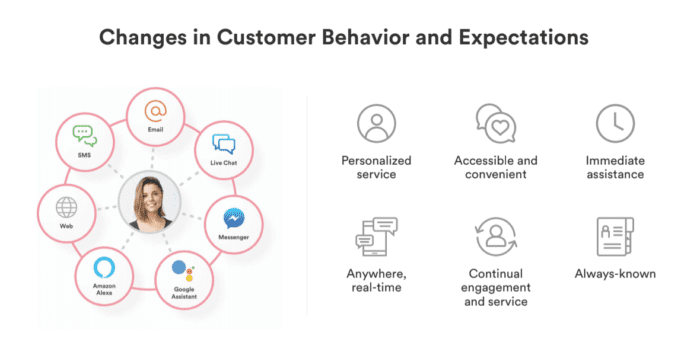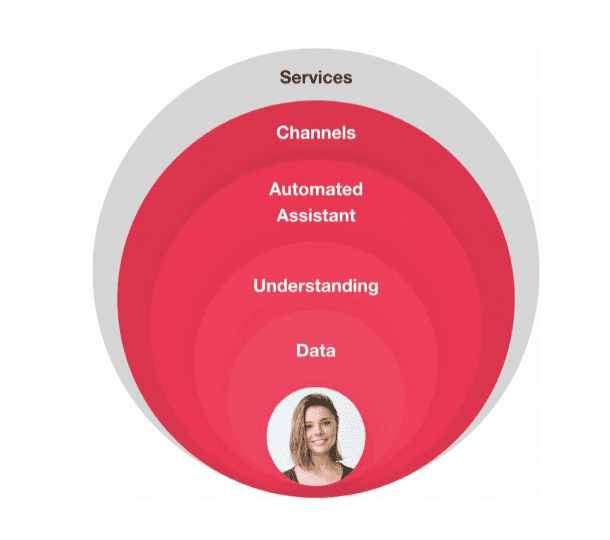As consumers are offered more, they also demand more from brands. Using AI strategically is the key to rise to that challenge.
Even successful brands know how hard it can be to reach their target audience at exactly the right moment with exactly the right message. Consumers just have too many ways to interact with your brand, ranging from their phones to their tablets to their laptops. They’re bombarded with messages on email, social media, and search engines.
It’s not surprising, then, that a study from Kantar found that more than half of consumers are totally apathetic toward advertising content and 70% see the same ads over and over again. A paltry 11% actually enjoy advertising. Your brand has to rise above all the noise in the marketplace to catch consumers’ attention.
But that’s not all: Once you reach consumers, the pressure is on to give them a perfect experience. Amazon has been able to provide its customers with quick product information, FAQs, information about tracking, returns, and more, and shoppers now expect to have all that at their fingertips. They expect to be able to contact brands at the time they prefer and on their favorite channel.
With these sky-high standards, it’s hard for a brand to know where to start. But one clear solution is starting to emerge: artificial intelligence.
AI helps marketers solve this dilemma
The good news is that the Kantar study found that consumers can engage with ads when they’re done right. These days, that usually means personalization, and with AI, brands can use all their data to build customer profiles. With AI, marketers can hit people with promotions, content, and messaging at their preferred time and on their channel of choice without being overly invasive.
AI also can serve customers with correct and accurate messaging. After all, according to the Kantar study, 45% of consumers say they find ads more interesting when they’re specifically tailored to their interests. AI also helps create holistic and seamless customer experiences. A customer profile that isn’t created using AI won’t be constantly evolving, learning, and adapting to user preferences and opt-ins.

Brands must be transparent
AI and machine learning gain knowledge from every input of data. First, data is fed into the AI engine, making the AI smarter. In order for AI to continue to work, big data needs to continue to grow and evolve, with the data being put into algorithms to automate the processes.
With all that knowledge being gathered, of course, retailers can deliver tailored content and apt recommendations based on data. But they must also readily pull back the curtain and explain what information they’re collecting, how, and why. For marketers, that means following the European Union General Data Protection Regulation, which requires companies to get consent to use data, tell consumers exactly what it’s being used for, and assure them that it won’t be used for anything else.
According to Article 22 of the GDPR, consumers have the right to not have an automated process make a decision about them that has legal effects and makes them entitled to an explanation of how a decision was reached.
In April 2019, Deb Fischer, R-Neb., and Mark Warner, D-Va., introduced a similar bill in the United States Senate. The Deceptive Experiences to Online Users Reduction Act would prohibit platforms with more than 100 million monthly users from using deceptive designs to trick users into sharing personal data. In other words, companies have to be transparent about how they are collecting consumer information.
3 strategies for using AI intelligently and responsibly
As you’re getting started with integrating AI into your marketing efforts, there are a few strategies that can help you be successful, smart, and responsible:
1. Show your hand
Following GDPR, companies should provide consumers the ability to see what data is being collected with the opportunity for opting out. Brands can share this information with consumers in a way that fits their brand tone and story. They can put this on their user preference pages, make it a part of the post-purchase experience, and make it personal to their brand.
Brands can even make GDPR sound like a customer service benefit. For example, when Lloyds Bank educated its email subscribers, it made sure to set out the parameters of the GDPR in terms that would make sense to its audience. It also incorporated its GDPR email campaign into a plain-English FAQ landing page on its site. The results were striking. Read rates of its notification emails increased while deleted-before-reading rates halved. Clearly, the bank found a way to harness transparency to build loyalty.

2. Understand your data
Personalization is key for improving the user experience. According to a report from SmarterHQ, 72% of consumers say they only engage with tailored marketing messages.
But before you start serving customers with personalized content and recommendations, make sure you have some ideas of what the data means and represents. Users should have the ability to opt in to their preferred channels and choose the types of content they want to see from your brand. Make sure all data is correct and that past purchases are included. Data should define what products customers have searched for and purchased, as well as their gender and location, and map them back to the appropriate product recommendation.
3. Be strategic about the data you have
By giving customers the ability to opt-out and set preferences, marketers have to be strategic and innovative with their data to make sure it has an impact. This innovation could mean only serving customers with the messaging that resonates with them. Or it could mean implementing chatbots that could be available on any channel.
Among U.S. adults, 95% have a smartphone, and more than half have a tablet, too. And more screens and devices are popping up daily. Devising that cross-platform strategy is truly putting marketers to the test and is fast becoming the pot of gold for businesses. Create a holistic experience while gathering customer data across all of those channels, including SMS, email, social media, and voice.
The fact that consumers’ expectations have risen so dramatically in recent years is a testament to the strides brands have made in using technology to enhance the customer experience. But the flip side is that as consumers are offered more, they also demand more from brands. Using AI strategically is the key to rise to that challenge.
